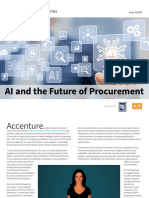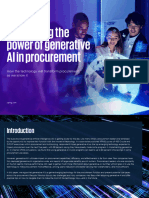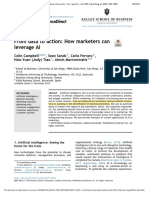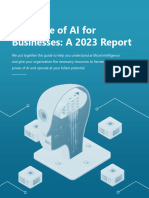An Executive Guide to
Evaluating AI
(beyond just Generative AI):
Use Cases and
Adoption Strategies
SPONSORED BY:
Ariba
spendmatters.com
� Evaluating 2023 has been dominated by generative AI headlines. Generative AI,
or “GenAI,” especially related to generative pre-trained transformers
AI (GPTs) that enable large language models (LLMs) such as GPT-4 (and
numerous others, including open-source models), has overshadowed
a large body of other non-generative AI/machine learning (AI/ML)
tools that help build up a collective set of purpose-built analytical
capabilities. These tools help generate predictive and prescriptive
insights to assist business users — quite often embedded “behind the
scenes” into business applications.
LLM-based chatbots have certainly captured imaginations because
of the engaging conversational user experience. However, the latest
advancements in GenAI are also a cause of massive upheaval in the
technology provider ecosystem. They have created equal measure of
hype/”FOMO” and concerns about data quality/reliability, explainability
(e.g., LLM-powered GenAI chatbots that “hallucinate” answers),
CHIEF PROCUREMENT security/privacy, responsibility/ethics, cost and tech ecosystem
OFFICER STATISTICS volatility in the market.
→ 70% of CPOs have seen risk
So, while the mega hyperscalers (like Google, Microsoft and AWS) and
continue to grow over the last
other best-of-breed GenAI providers (like OpenAI, Cohere, Anthropic)
12 months and their perceived
battle it out to build the largest generalizable LLMs, there are plenty
effectiveness as a business
of old-school “mundane” AI areas that are narrowly focused but still
partner has dropped given the
valuable from an automation standpoint.
multiple priorities.
→ 87% of CPOs agree that talent is This is especially true in a source-to-pay (S2P) context. For both
the single greatest factor in driving upstream (source-to-contract) and downstream (purchase-to-pay)
procurement performance, but processes (and broader enterprise processes such as supply chain,
roughly half do not believe they finance, etc.), AI has increasingly played a larger role in everyday
have the talent they need (with processes, leading to increased efficiency and quicker time-to-value
digital training being the largest on key technology investments. While this AI may not be as flashy or
perceived gap). trendy as generative AI, it is hugely valuable in terms of improving digital
capabilities and business outcomes.
→ Talent is drowning in data and tools
but starving for insights. Tech
budget allocation has dropped
Why traditional and generative AI are both
and this under-resourcing and needed for broader supply-side automation
poor data quality are the top two Procurement needs to augment its internal knowledge and skills with
digital barriers. “outside-in” intelligence to help stakeholders identify opportunities and
risks to prioritize and act upon. The sheer volume of data and business/
Source: 2023 Deloitte CPO Study (in
market complexity is overwhelming the function and its staff. CPOs
collaboration with Spend Matters)
recognize this problem keenly. See sidebar.
AI/ML of all forms is needed, therefore, to augment the typically under-
resourced and outmatched supply professionals and their stakeholders
(internal and suppliers) that are seeking to improve their analytical
capabilities to automate away lower-value activities.
In this analysis, we focus on AI/ML use cases in S2P that are currently
adding value in the field and we augment those examples with
select generative AI trends that are gaining traction (and give some
recommendations to overcome the most pressing emerging issues).
spendmatters.com 2
Ariba
� Use Case: AI is working its way into business systems and into S2P software (in fact,
roughly 20% of the functional requirements in our S2P SolutionMap
Spend vendor benchmarking assessment include ML/AI within the individual
Analytics
enumerated scoring scales). Throughout the most popular S2P
modules, AI-based features improve efficiency and effectiveness
within transactional processes, internal analytics, data pipelines, master
data management, risk/compliance support and other areas. While
some of these AI examples may be somewhat difficult to notice relative
DISCRIMINATIVE AI to some of the newer LLM-based generative AI use cases, they are also
VS. GENERATIVE AI easier to implement because they are usually baked into the platform
Generative AI is a relatively new itself.
technique that uses advanced
machine learning to generate
predicted content outputs based AI Use Cases by Procurement Area
on user-prompted inputs (done via
deep data patterns established in
Spend Analytics Sourcing
pre-trained LLMs). Discriminative/ Better modeling, data management Category Intelligence and
traditional AI modeling pertains to and spend insights guided/autonomous sourcing
simpler prediction algorithms (e.g.,
using supervised machine learning
for highly bounded analytical
tasks) such as the classification/ Augmented
clustering and tagging (i.e., Intelligence via
“feature extraction”) of structured AI/ML
data. Purchase-to-Pay (some of it GenAI) Contract
(including intake Management
management) From risk-transfer
Examples of this include contract/ documents to deep
Stakeholder intake,
invoice document conversion experience, guidance and commercial data/insights
autonomous workflows
(from document files to structured
sets of data values) or spend
classification to a target spend
Supplier
category taxonomy. For the
Management
contract example, generative Supplier risk/compliance
modeling involves the creation of and engagement
new material (e.g., generating new
clause language in a contract in
response to a supplier-originated Spend Analytics
contract agreement), while
discriminative modeling makes → Taxonomy-building and classification for spend data and associated
decisions based on differences master data (supplier, organization, chart-of-accounts, contracts,
the model has learned between material/service masters, etc.) helps model the hierarchies and
different data sets (e.g., extracting associated data attributes for use in various analytics.
out contract/clause metadata to → Graph databases for richer data/knowledge modeling beyond
predict a contract type or clause relational database models. We expect that these data/knowledge
type to populate a CLM module graphs will be critical to augmenting LLM-based GenAI models for
in a S2P suite or a linked CLM explainability and efficiency.
system).
→ AI-enabled spend data classification can be done via supervised
learning models/algorithms that help accurately classify spend data
to standardized target taxonomies. Probabilistic confidence scoring
helps humans review the models and create repeatable/portable
rules to improve match rates and data quality.
spendmatters.com 3
Ariba
�Use Case:
→ AI-based data cleansing and normalization algorithms help remove
duplicate data, fill in missing data and then format the remaining
Sourcing data. This enables organizations to normalize data across multiple
ERPs, languages and business units in a timely manner. If the data isn’t
cleansed and normalized, it cannot effectively be analyzed!
→ Specialized data partnerships and benchmarking insights paired
with AI add more data insights. Supplier master deduplication helps
deliver volume leverage savings, and duplicate material master data
also enables inventory-reduction opportunities. Benchmarking brings
collective insights for opportunity identification, and many external
benchmarks themselves are developed with AI (e.g., commodity price
forecasts or contingent labor-rate benchmarking).
Sourcing
→ AI can “generatively” auto-create sourcing events based on templates
— matched against event content (e.g., category) and/or historical
events (can be community-based). Suppliers are then automatically
assigned (matched between supplier status/qualifications and event
content) and even awarded. This frees up time for end users who can
then re-allocate their time on higher-value activities.
→ Some solutions can also use AI to suggest suppliers based on
specific criteria (performance, risk, past events, etc.) and can detect
opportunities based on market trends. Supplier discovery is also
mentioned below.
→ AI analyzes historical data and market trends to forecast demand,
which helps identify when to source and what opportunities to target.
Better demand data also helps firms identify more levers to pull for
value creation.
→ Intelligently guided category strategy and sourcing execution allows
for real-time and automated insights derived from specific market/
category attributes to then drive categories strategies and workflow
content (e.g., auto-creation of tailored n-step processes, supplier
shortlists, event strategy, RFx documents, and even SoWs. AI can
also streamline the UX away from hard-coded business logic towards
intelligent chatbots that ask a minimum set of needed context-specific
prompted questions.
→ Sourcing solutions can also use AI to auto-suggest optimized prices by
pulling cost elements from several sources (community, market indices
and historic events/supplier behavior) to give buyers a benchmark
“anchor” price and even recommended supplier “nudges” to improve
event outcomes. Bots can also be deployed here.
→ AI is very impactful in complex sourcing events via combinatorial bid
optimization. Complex sourcing events (e.g., transportation sourcing)
accommodate a vast amount of core data (scenarios, line items,
cost elements, suppliers) and allow suppliers to flexibly bundle and
bid on line items that best meet their capabilities. These bids are
then optimized/allocated in a way typically impossible for humans to
manage.
spendmatters.com 4
Ariba
�Use Case: → AI-enabled opportunity detection and recommendations involve the
use of data, benchmarks (historical, community, market, etc.) and
Supplier playbooks to identify opportunities, assess and prioritize them (by
Management
value and feasibility) and deliver targeted recommendations rather
than forcing users to go fishing in dashboards. Service providers of
various stripes also serve up these analytics in various commercial
models (e.g., contingency).
Supplier Management
→ AI-enhanced supplier discovery involves the analysis of requests/
needs on one side to match to eligible suppliers. A deep AI
understanding of language about/from suppliers helps transcend a
reliance on structured data to more quickly match suppliers to needs
and expand the supplier network pool. Such smart matching can also
be extended to performing continuous best-fit scoring to assess
whether suppliers are still suitable.
→ AI also helps profile suppliers more richly (who they are, what they do,
who they work with) by capturing and analyzing data sources (public
and purchased data, connected databases, spend, etc.) to provide
deeper insight.
→ AI can embed relevant and contextual community intelligence
into Supplier Management processes to help provide “outside-
in” collective insights and benchmarks that can instantly augment
existing supplier profiles.
→ AI can leverage unstructured communication to capture and assess
behavioral/sentiment elements. Data sources can include emails,
in-app messages and even external data feeds. These are then
translated into factual indicators that can allow users to understand
relationships by including “soft” (human) elements that are not
typically included in supplier management but that are often more
relevant than “hard” facts.
→ AI can capture and analyze real-time supplier risk signals from
multiple sources to identify potential risks and contextualize them
(via dashboards, alerts, etc.) to each user based on internal data. This
continuous and automated monitoring of risk signals also employs
machine learning to reduce false positives and end-user effort.
→ AI can also be more prescriptive and recommend risk-mitigation
plans by leveraging historical data, market/community data and a
customer’s risk profile in order to identify priority areas to mitigate
and build future resilience. This again lessens manual effort, shortens
disruption reaction/recovery time and mitigates future risks.
spendmatters.com 5
Ariba
�Use Case: Contract Lifecycle Management
CLM & P2P → AI scans contracts upon upload (in batch or dynamically from
counterparties), extracts the contents and categorizes by what
it recognizes as important. By automatically extracting key
information, these solutions not only save organizations time but
allow for quick access to the most relevant aspects of a particular
agreement (dates, parties, clauses, obligations, etc.) for subsequent
deeper analysis.
→ AI suggests clauses during the negotiation and authoring processes.
Factors such as the agreement type and the user roles can drive
recommendations for best-fit existing/approved clause language.
This saves time during the authoring process and allows users to
choose terms that are more applicable to the specific negotiation.
GenAI can enhance this further by translating and summarizing
“legalese” to ordinary business users.
→ Solutions can also flag areas of note (configured by the user).
Using data from past negotiations and agreements, AI identifies
potential issues (such as language that does not closely align with
the organization’s playbook) for further review. This is especially
useful for supplier-originated contract drafts and helps cut down
on manual review time which can create delay and cost (especially if
external legal counsel resources are used).
→ Moreover, AI-enabled risk detection (clause- and contract-level)
is valuable in CLM. AI uses data from past agreements to compare
language and identify areas that present risks to the organization
(compliance, finance, etc.) that have been modeled and used to
train the AI. These are usually displayed as a percentage or on a low-
medium-high scale. Overall, it helps to streamline manual review
resources and set priorities for negotiation.
Procure-to-Pay
→ AI can be involved in casual buying. In this scenario, AI goes beyond
basic rules and workflows by analyzing system data and patterns
to suggest the most optimal purchasing methods, such as utilizing
catalogs, e-forms and other options. This ensures that purchases
adhere to company guidelines, fulfill user requirements and align
with business objectives. A guided buying experience streamlines
and improves the procurement process, resulting in a more user-
friendly and customized experience that also supports spend
category requirements.
→ AI can also be involved in tail spend control, which encompasses
one-off or uncommon purchases. AI can offer several benefits in
this context, such as (1) categorizing and classifying tail spend items,
(2) evaluating the vendor landscape to identify opportunities for
consolidating tail spend with preferred or contracted suppliers,
(3) automating process orchestration related to tail spend, (4)
spendmatters.com 6
Ariba
� What to suggesting alternatives or preferred products or suppliers, (5)
potentially feeding a tail spend sourcing event, (6) providing in-
Consider depth insights into tail spend data to reduce costs.
→ Solutions also use AI to identify fraudulent activities such as double
billing, fake invoices, inflated invoices, fraudulent internal billing,
SOURCE-TO-PAY IS ONLY ONE ASPECT
etc. AI plays a crucial role in this context by continuously monitoring
OF BROADER SUPPLY-SIDE AI
transactions and alerting stakeholders to any irregularities that
S2P is a core supply-side set of processes, but might signify fraudulent behavior. By leveraging historical data
S2P helps manage supply as well as spend (i.e.,
“spend is what you pay and supply value is what
and machine learning, AI-powered solutions can even forecast
you get”), and this includes the inbound supply potential fraud risks. This not only safeguards an organization’s
chains/networks and associated third parties financial assets but also mitigates the likelihood of data breaches,
needed to help run end-to-end value chains. This
thereby minimizing the associated costs, legal consequences and
implies “extended spend/supply management”
use cases such as: broader brand damage.
→ AI-based optimization of supply chain → AI is also used to facilitate n-way matching of invoices, reducing
networks by again ingesting vast amounts
of data (in this case, lanes, nodes, modes,
errors and accelerating the process. This technology can extract
prices, tiers, etc.), considering multiple and interpret textual and numerical data from paper or scanned
constraints and identifying opportunities invoices.
for improvement (e.g., changing suppliers,
location of warehouses, changing mode, → AI can also be applied in this context of Dynamic Discounting
etc.). This enables organizations to have a use cases. The aim is to forecast early payment offers that not
digital twin of their supply chain to analyze and
simulate sensitivity to various demand signals
only entice suppliers but also achieve a high adoption rate. This
and identify areas for improvement (cost, AI analysis considers supplier activities, demographics, financial
resilience, carbon, etc.). profiles and their interactions across multiple buyers.
→ Supply chains produce products, and
broader value chains produce information
→ AI can optimize Travel and Expenses (T&E) management by
and services, but they also produce CO2. AI improving hotel receipt itemization, ensuring that expenses are
is also helping the sustainability agenda by transparently and accurately accounted for. AI can also play a role
helping firms estimate their CO2 footprints for
in increasing the accuracy of cost estimates for T&E by leveraging
Scope 3 emissions reporting and reduction.
For the vast majority of firms without deep historical data and predictive analytics. This enhanced accuracy
n-tier supply network models, this estimation ensures that budgets are well-optimized, preventing budget
work requires heavy lifting, and this is where overruns and unexpected expenses.
AI tools are helping to better estimate this
carbon footprint using AI models that take
inputs, such as spend category, supply Implementation Considerations and
network characteristics, product mass (and
material composition), etc., and develop more
Recommendations
fine-grained outputs that allow more realistic
Although GenAI holds the promise to offer leapfrog improvements
target setting and tracking.
in the areas of user engagement, as well as behind-the-scenes
All these areas are great news for CPOs
capabilities such as language translation and other deep learning
who want their supply networks to support
broader enterprise goals for ESG and supply abilities, traditional AI will continue to improve alongside GenAI and
chain resilience. Aspirationally, ESG is the work in concert with it. Not only will new capabilities be added to
top area that gets CPOs most excited about solutions, but existing models will become more powerful, leading
their profession, and operationally, these
AI-enhanced analytics provide higher-fidelity
to increased accuracy and faster processing times. This increasing
data to feed into their sourcing processes — as synergy is also critical to the challenging issues of transparency/
evidenced by the fact that 83% of procurement explainability, IP protection, processing costs and flexibility/future-
top performers/“orchestrators” fully embed
proofing. Based on our discussions with practitioners, tech providers
risk evaluation into the sourcing process (as
compared to 30% for their peers).1 and service providers, we’d like to offer the following considerations
and recommendations:
1 2023 Deloitte CPO Study ( jointly developed with
Spend Matters)
spendmatters.com 7
Ariba
� Typical Insights to
questions consider
AI technology should be provided by core application
suites and specialist applications (and the hyperscalers
eager to provision it) for the types of areas covered in
How to best this report, but may certainly be being built out by more
source AI advanced organizations in strategic process areas. As
capabilities they build out broader digital platform elements such
overall for S2P as analytics, data management (e.g., data pipelines and
requirements data fabric), orchestration automation (workflow/BPM,
RPA, process mining, integration, etc.) and UX-focused
development (e.g., low-code/no-code), IT will be a key
function for CPOs to stay aligned with.
Every firm should immediately consider application of the
technology — even just to get employees familiar with
its possibilities. IT should also be consulted to support
How to consider
sandbox activities including POCs that can be pursued
and implement
solo, but also with tech/service vendors that are investing
GenAI given
heavily and seeking early adopters. Large application
the newness
vendors are making commitments to strategically partner
and uncertainty
(and invest in) major LLM providers to securely access their
with the
models via APIs with guardrails, data privacy options, cloud
technology and
deployment options, partner access layers, and integration
market
to the providers’ evolving next-generation technology
platforms (either as standard functionality or via an AI-
enhanced version).
Although there is a short-term window to access
LLMs more cost effectively as providers seek market
penetration, the bills will eventually come due. So, clearly
understand the application vendors’ commercial models,
especially since they too are trying to understand the
economics and technology adoption lessons. Players
How to manage across the ecosystem are also testing out specialized,
increasingly open-source models tuned for various purposes (such as
large, code development) and app vendors are trying to tune
compute- these models and leverage them in more efficient (and
intensive and ethical/risk-aware) ways. More broadly, although LLMs
expensive LLMs bring higher compute costs, they can also create a derived
ROI in knowledge-centric services such as legal services,
BPO/MSP, consulting, DevOps, application management
and others. Smart CPOs, CIOs/CTOs, CFOs and shared
service leaders are already seeking to reap supplier
innovation expectations in the form of cost savings and
other tangible business benefits.
spendmatters.com 8
Ariba
�In GenAI is a truly transformational technology, unlike, say,
Conclusion
blockchain building better transaction ledgers. Although
initial use cases are focused heavily on UX (allowing users
to “talk to the apps” and conversationally drive system
functionality), its real power lies in its ability to see deep
data patterns and universally translate any “language”
— unstructured text in documents or across the web,
“legalese” dialects in contracts, even computer code
Whether (enabling next-gen no-code/low-code/pro-code
GenAI, which environments). Yet, language alone doesn’t provide deeper
is currently meaning, and the language models in LLMs need to speak
(largely) the language of the data that sits within the massively
complex data models of business apps.
chatbot-
centric, is just a Case in point, SAP CEO recently stated that SAP’s LLM-
fad and a “nice based chatbot Joule “will know what you mean, not just
what you say.” And SAP’s head of product engineering
to have”
also said that “we have more than 20,000 customers
who gave us consent that we use that data for showing
in an anonymized fashion, that we use that data to train
models — and that’s part of our contract. That’s the reason
we can build up this huge SAP foundational model — most
probably 200,000 database tables.” This is a telling
description of the collective business-focused intelligence
that will soon be on tap.
LLMs can certainly be better focused using techniques
such as fine-tuning, prompt engineering, RAG (which draws
from an enterprise-specific data set to prompt an LLM) and
other techniques. But, although the proverbial probabilistic
How language “black box” can be made smaller, and explicit data inputs
models to the model made explicit to the user, companies should
proceed with caution to use the outputs blindly. This is why
can stop
an augmented intelligence of providing recommended/
hallucinating
generated outputs to the user via a deterministic algorithm
and be able used within a business application (e.g., via an increasing
to improve set of formal APIs) is so attractive. This translation from a
explainability language model to a structured data model is also made
easier by a semantic knowledge model powered by a
[non-relational] graph database. We predict that graph
databases will explode in popularity because of their ability
to cross these two worlds.
Looking Forward
AI is clearly a massively complex area to understand and apply to
procurement and the broader business. But given its ability to shape and
disrupt supply markets and the spend/supply management processes
that tap those markets, CPOs and other business executives need to
“know what they don’t know” and get savvy on how to understand and
apply this emerging class of game-changing technology. It’s also an
opportunity to exhibit digital leadership and “lead by example” in applying
this inherently data-focused technology to better integrate and infuse
intelligence into the vast landscape of enterprise applications.
spendmatters.com 9
Ariba
� SAP helps bring simplicity and clarity to all
types of spending from all across a company.
With spend management and business
network solutions from SAP, companies can
guide employees to smart spending decisions,
partner with the rest of the organization and
work closely with suppliers to make sure
every transaction is a strategic investment.
Interested in speaking with an
SAP representative?
Contact us today
Ariba
©Spend Matters. All rights reserved.






















































































